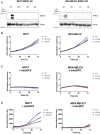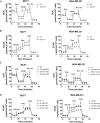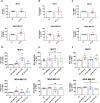NDRG1 acts as an oncogene in triple-negative breast cancer and its loss sensitizes cells to mitochondrial iron chelation
- PMID: 38983911
- PMCID: PMC11231402
- DOI: 10.3389/fphar.2024.1422369
NDRG1 acts as an oncogene in triple-negative breast cancer and its loss sensitizes cells to mitochondrial iron chelation
Abstract
Multiple studies indicate that iron chelators enhance their anti-cancer properties by inducing NDRG1, a known tumor and metastasis suppressor. However, the exact role of NDRG1 remains controversial, as newer studies have shown that NDRG1 can also act as an oncogene. Our group recently introduced mitochondrially targeted iron chelators deferoxamine (mitoDFO) and deferasirox (mitoDFX) as effective anti-cancer agents. In this study, we evaluated the ability of these modified chelators to induce NDRG1 and the role of NDRG1 in breast cancer. We demonstrated that both compounds specifically increase NDRG1 without inducing other NDRG family members. We have documented that the effect of mitochondrially targeted chelators is at least partially mediated by GSK3α/β, leading to phosphorylation of NDRG1 at Thr346 and to a lesser extent on Ser330. Loss of NDRG1 increases cell death induced by mitoDFX. Notably, MDA-MB-231 cells lacking NDRG1 exhibit reduced extracellular acidification rate and grow slower than parental cells, while the opposite is true for ER+ MCF7 cells. Moreover, overexpression of full-length NDRG1 and the N-terminally truncated isoform (59112) significantly reduced sensitivity towards mitoDFX in ER+ cells. Furthermore, cells overexpressing full-length NDRG1 exhibited a significantly accelerated tumor formation, while its N-terminally truncated isoforms showed significantly impaired capacity to form tumors. Thus, overexpression of full-length NDRG1 promotes tumor growth in highly aggressive triple-negative breast cancer.
Keywords: GSK3α/β; NDRG1; breast cancer; mitoDFO; mitoDFX; mitochondrial iron chelation; oncogene; tumor suppressor.
Copyright © 2024 Jadhav, Vondrackova, Potomova, Sandoval-Acuña, Smigova, Klanicova, Rosel, Brabek, Stursa, Werner and Truksa.
Conflict of interest statement
The authors declare that the research was conducted in the absence of any commercial or financial relationships that could be construed as a potential conflict of interest. The author(s) declared that they were an editorial board member of Frontiers, at the time of submission. This had no impact on the peer review process and the final decision.
Figures








Similar articles
-
The metastasis suppressor, N-myc downstream-regulated gene 1 (NDRG1), inhibits stress-induced autophagy in cancer cells.J Biol Chem. 2014 Apr 4;289(14):9692-709. doi: 10.1074/jbc.M113.529511. Epub 2014 Feb 15. J Biol Chem. 2014. PMID: 24532803 Free PMC article.
-
The iron chelators Dp44mT and DFO inhibit TGF-β-induced epithelial-mesenchymal transition via up-regulation of N-Myc downstream-regulated gene 1 (NDRG1).J Biol Chem. 2012 May 18;287(21):17016-17028. doi: 10.1074/jbc.M112.350470. Epub 2012 Mar 27. J Biol Chem. 2012. PMID: 22453918 Free PMC article.
-
Molecular functions of the iron-regulated metastasis suppressor, NDRG1, and its potential as a molecular target for cancer therapy.Biochim Biophys Acta. 2014 Jan;1845(1):1-19. doi: 10.1016/j.bbcan.2013.11.002. Epub 2013 Nov 21. Biochim Biophys Acta. 2014. PMID: 24269900 Review.
-
[Overexpression of NDRG1: relationship with proliferative activity and invasiveness of breast cancer cell line and breast cancer metastasis].Zhonghua Bing Li Xue Za Zhi. 2006 Jun;35(6):333-8. Zhonghua Bing Li Xue Za Zhi. 2006. PMID: 16834906 Chinese.
-
The role of the NDRG1 in the pathogenesis and treatment of breast cancer.Biochim Biophys Acta Rev Cancer. 2023 May;1878(3):188871. doi: 10.1016/j.bbcan.2023.188871. Epub 2023 Feb 24. Biochim Biophys Acta Rev Cancer. 2023. PMID: 36841367 Review.
Cited by
-
Traditional Chinese Medicine and Ferroptosis in Intracerebral Hemorrhage: A Potential Therapeutic Approach.Drug Des Devel Ther. 2025 Jun 4;19:4789-4808. doi: 10.2147/DDDT.S513343. eCollection 2025. Drug Des Devel Ther. 2025. PMID: 40486126 Free PMC article. Review.
-
Insight into the Regulation of NDRG1 Expression.Int J Mol Sci. 2025 Apr 10;26(8):3582. doi: 10.3390/ijms26083582. Int J Mol Sci. 2025. PMID: 40332138 Free PMC article. Review.
References
-
- Chen Z., Zhang D., Yue F., Zheng M., Kovacevic Z., Richardson D. R. (2012). The iron chelators Dp44mT and DFO inhibit TGF-β-induced epithelial-mesenchymal transition via up-regulation of N-Myc downstream-regulated gene 1 (NDRG1). J. Biol. Chem. 287 (21), 17016–17028. 10.1074/jbc.M112.350470 - DOI - PMC - PubMed
LinkOut - more resources
Full Text Sources
Miscellaneous

